I really love root over rock style bonsai, especially trident maples. Well established trees have roots that flow over and flatten out to clasp the rock as if the tree has been there for ages. I have been experimenting with ways to develop root over rock bonsai for more than 20 years in an endeavour to produce ever better root over rock plantings.
The old Japanese method was to paste ‘muck’ (a mix of clay and cow manure) onto the surface of the rock where the roots are to grow then press the roots of a seedling into it and plant the result into a pot or the field. When I tried this I found many of the roots with muck rotted and new ones sprouted which often were not in contact with the rock, spoiling the arrangement. Even if the roots in muck survived, new roots often sprouted and grew off into the surrounding soil. These new roots often grew better than the carefully arranged roots on the rock and left large scars when removed. Panty hose was suggested as a way of holding roots onto the rocks but roots grow through and the nylon takes a very long time to degrade and is almost impossible to remove once the roots have grown through it. Cling wrap and electrical tape were other methods trialled. These work really well but only on convex surfaces. If the rock has a hollow the wrap spans straight across, leaving the roots underneath free to wander away from the surface of the rock. Eventually I tried another material from the kitchen drawer which has worked best and produces excellent results more often than any other I have tried.
Here’s what you need:
Trident maple seedlings: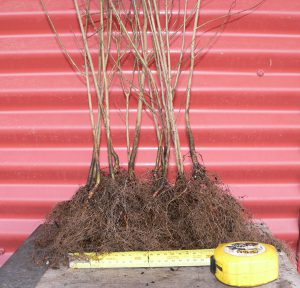
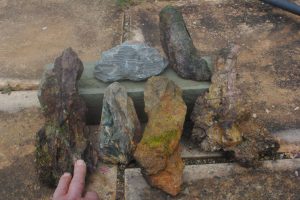
Some of the seedlings will have a single strong ‘taproot’. Put them aside for other projects. Select the ones with several strong roots that will go over your rock. Wide spread roots will usually fit better than strong vertical ones ( the trunk usually splits or roots break off when you try to force the base of the trunk tight against the rock)
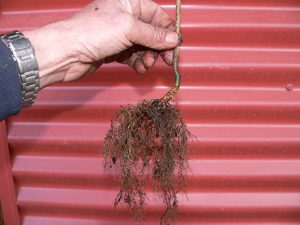
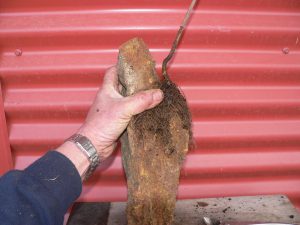
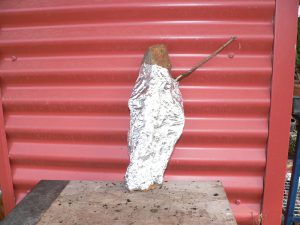
Now plant the whole thing up to the base of the trunk. the pressure of the soil will push the foil and roots within close against the rock surface. Do not let the soil cover the top of the foil because tridents will send out new surface roots at the expense of your chosen root hugging ones.
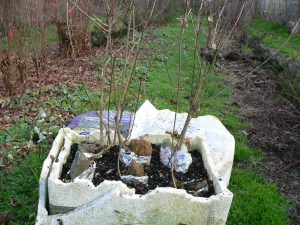
After a year you can unpot the tree and unwrap it to check progress. The foil will have started to decay and will probably need replacing anyway.
At this stage you may still be able to make modifications to the roots if they are not in the ideal positions. If lots of new roots have sprouted you can remove some to leave discrete roots running down the rock. Where roots cross, the top root will be pushed away from the rock as the one under it thickens so try to avoid crossing roots.
Lots of roots close together will merge into a single plate of root over time.
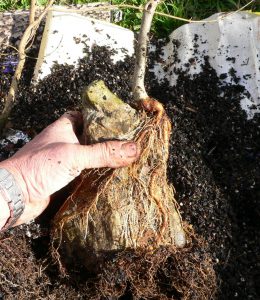
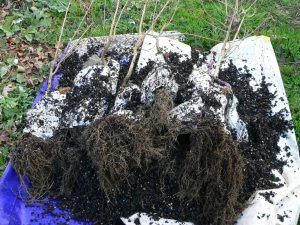

Great! Thanks for sharing this info Neil. i’ve got a couple of trident root over rock and i love them…guess where i got them from? 🙂 shibui of course but I will experiment and try to grow one myself.
Hi Neil,
Thats a really clear write up. Its interesting that foil won out in the kitchen material challenge, i hadnt thought about the concave parts of the rock and that string, gladwrap etc were a problem in those cases. It makes a lot of sense when you think about it.
Joe.
Neil.
Thanks mate will show you my root over rock in five years.
Regards.
Irish, Junee
Hi Neil
Potted up a couple of Japanese maple groups this arvo from a box of seedlings I raised (had to rush as the buds were opening on some). Noted an interesting seedling – a bit crooked with naturally spreading roots – on 3 sides !. Seemed an ideal candidate to try out your root-over-rock instructions. The maple now has a slanting design, reaching over the front edge of the rock. Might look good if all goes well in these next few weeks.
Thanks for sharing your hard earned experience in this area with other bonsai artists …
Mike, Canberra
Good to see this idea is getting a few followers. Good luck with yours Mike. Opening them up next year is like Christmas presents – the anticipation to finally see the results……..
Definitely going to try this. Most natural Ficus root over rock trees here send out roots over rocks in fissures – sometimes over bare rock if the season is wet enough.
Thanks for the info.
Lennard
Hi Neil,
Thank for the very nice blog…I have been reading it for a very long time now, and did not know You post on the AF.
I need to make one blog also.
Glad to be able to put up something interesting for you in Africa Neli. Blog is quite easy. Mine is a commercial template with some cost but a simple blog page can be free. You should start soon.
Neil
Thank you very much for this Neil =) i was looking for a new technique hope it works on my Acer palmatum ,…
Good luck Timo. It is easier to get roots of A. palmatum to stay where you put them. They do not have the same tendency to produce new roots that tridents do but the foil will help hold the roots close to the rock while they grow. Unfortunately A palmatum roots do not thicken as quickly as trident roots so you we will both be waiting for a few years to have really good A. palmatum root over rock bonsai.
I followed your advise….though I missed this. My email got hijacked and deleted…
Still coming back again and again.
Here is the new blog:
http://nelibonsai.wordpress.com/2013/08/13/sizigium-airlayer/?preview=true&preview_id=375&preview_nonce=1925c5ad7c&post_format=standard
This is great, thanks! Did you ever try this with mugo pines or other pines like JBP or red/ white pines? How about with junipers, any luck with them.
D
I have both Japanese Red and Japanese Black pines on rocks as well as ficus rubiginosa. It is not quite so critical to wrap the roots of pines because they do not have the same tendency to develop surface roots but the foil will help hold the roots close to the rock. The other thing with pines and junipers is that the roots thicken comparatively slowly so it takes far longer to get a convincing tree than with tridents or figs. I have only just started to train the canopy of my pines after more than 10 years waiting for the roots to develop.
Pingback: Root over Rock Trident Maples | Shibui Bonsai